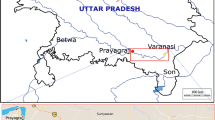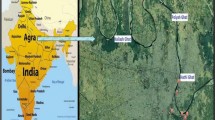Abstract
Cyanobacterial blooms are harmful because of their cyanotoxins production. It occurs due to the eutrophication of freshwater reserves. Nagpur city has three lakes which serves as public water resource and are affected by algal bloom events. Metagenomic approach was used for the exploration of taxonomic, catabolic, and resistome profile of these lakes. Taxonomic profiling indicated prevalence of cyanobacterial species like Microcystis, Anabaena, Trichodesmium, Microcoleus, and Nodularia. These bacteria are well known for their association with algal bloom and microcystin production. High Performance Liquid Chromatography (HPLC) detected the presence of microcystin toxin and concentration was relatively higher in Ambazari lakewater. In addition, the presence of several antibiotic resistance genes like vancomycin, beta-lactamase, methicillin, and fluoroquinolones were observed. Genes conferring metal resistance such as copper, cadmium, zinc were also mined indicating presence of metal resistant microorganisms. The study suggests that lake water contaminated with Microcystis (algal bloom) harbors complex microbial community having diverse catabolic and resistome profiles, which negatively affect the ecosystems services.



Similar content being viewed by others
References
Bardou P, Mariette J, Escudié F, Djemiel C and Klopp C 2014 Jvenn: an interactive Venn diagram viewer. BMC Bioinform. 15 293
Batista A, Woodhouse J, Grossart H-P and Giani A 2019 Methanogenic archaea associated to Microcystis sp. in field samples and in culture. Hydrobiologia 831 163–172
Bengtsson-Palme J and Larsson DG 2015 Antibiotic resistance genes in the environment: prioritizing risks. Nat. Rev. Microbiol. 13 396
Beversdorf LJ, Chaston SD, Miller TR and McMahon KD 2015 Microcystin mcyA and mcyE gene abundances are not appropriate indicators of microcystin concentrations in lakes. PLoS One
Bif MB, de Souza MS, Costa LDF and Yunes JS 2019 Microplankton community composition associated with aggregations of toxic Trichodesmium in the Southwest Atlantic Ocean. Front. Marine Sci. 6 23
Deng Y, Wu M, Zhang H, Zheng L, Acosta Y and Hsu T-TD 2017 Addressing harmful algal blooms (HABs) impacts with ferrate(VI): Simultaneous removal of algal cells and toxins for drinking water treatment. Chemosphere 186 757–761
Fire SE, Browning JA, Durden WN and Stolen MK 2020 Comparison of during-bloom and inter-bloom brevetoxin and saxitoxin concentrations in Indian River Lagoon bottlenose dolphins, 2002–2011. Aquat. Toxicol. 218 105371
Founou RC, Founou LL and Essack SY 2017 Clinical and economic impact of antibiotic resistance in developing countries: a systematic review and meta-analysis. PLoS One 12 e0189621
Goyal MK and Surampalli RY 2018 Impact of climate change on water resources in India. J. Environ. Engin. 144 04018054
Grabowska M and Pawlik-Skowrońska B 2008 Replacement of chroococcales and nostocales by oscillatoriales caused a significant increase in microcystin concentrations in a dam reservoir. Oceanol. Hydrobiol. Stud. 37 23–33
Guo J, Li J, Chen H, Bond PL and Yuan Z 2017 Metagenomic analysis reveals wastewater treatment plants as hotspots of antibiotic resistance genes and mobile genetic elements. Water Res. 123 468–478
Guo Y, Liu M, Liu L, Liu X, Chen H and Yang J 2018 The antibiotic resistome of free-living and particle-attached bacteria under a reservoir cyanobacterial bloom. Environ. Int. 117 107–115
Hofer U 2013 Getting to the bottom of cyanobacteria. Nat. Rev. Microbiol. 11 818–819
Huisman J, Codd GA, Paerl HW, Ibelings BW, Verspagen JMH and Visser PM 2018 Cyanobacterial blooms. Nat. Rev. Microbiol. 16 471–483
Kovalakova P, Cizmas L, McDonald TJ, Marsalek B, Feng M and Sharma VK 2020 Occurrence and toxicity of antibiotics in the aquatic environment: a review. Chemosphere 251 126351
Laczny CC, Kiefer C, Galata V, Fehlmann T, Backes C and Keller A 2017 BusyBee Web: metagenomic data analysis by bootstrapped supervised binning and annotation. Nucleic Acids Res. 45 W171–W179
Li Q and Zhang Q 2020 Prevalence and pollution characteristics of antibiotic resistant genes in one high anthropogenically-impacted river. PLoS One 15 e0231128
MacFadden DR, McGough SF, Fisman D, Santillana M and Brownstein JS 2018 Antibiotic resistance increases with local temperature. Nat. Clim. Chang. 8 510–514
Maske SS, Sangolkar LN and Chakrabarti T 2010 Temporal variation in density and diversity of cyanobacteria and cyanotoxins in lakes at Nagpur (Maharashtra State) India. Environ. Monitor. Assessment 169 299–308
McAlice BJ 1971 Phytoplankton sampling with the Sedgwick-Rafter Cell 1. Limnol. Oceanogr. 16 19–28
McArthur AG and Tsang KK 2017 Antimicrobial resistance surveillance in the genomic age. Ann. NY Acad. Sci. 1388 78–91
McLellan NL and Manderville RA 2017 Toxic mechanisms of microcystins in mammals. Toxicol. Res. 6 391–405
Pal M, Pal S, Qureshi A and Sangolkar L 2018 Perspective of cyanobacterial harmful algal bloom (HAB) mitigation: Microcystis toxin degradation by bacterial consortia. Indian J. Exp. Biol. 56 511–518
Pal M, Yesankar PJ, Dwivedi A and Qureshi A 2020 Biotic control of harmful algal blooms (HABs): A brief review. J. Environ. Manag. 268 110687
Pal M, Purohit H and Qureshi A 2021 Genomic insight for Algicidal activity in Rhizobium sp. (AQ_MP). Arch. Microbiol. 203 5193–5203
Parks DH, Tyson GW, Hugenholtz P and Beiko RG 2014 STAMP: statistical analysis of taxonomic and functional profiles. Bioinformatics 30 3123–3124
Proença L, Tamanaha M and Fonseca R 2009 Screening the toxicity and toxin content of blooms of the cyanobacterium Trichodesmium erythraeum (Ehrenberg) in northeast Brasil. J. Venom. Animals Toxins Trop. Dis. 15 204–215
Reardon S 2014 Antibiotic resistance sweeping developing world: bacteria are increasingly dodging extermination as drug availability outpaces regulation. Nature 509 141–143
Riebesell U, Aberle-Malzahn N, Achterberg EP, et al. 2018 Toxic algal bloom induced by ocean acidification disrupts the pelagic food web. Nat. Clim. Chang. 8 1082–1086
Sangolkar LN, Maske SS, Muthal PL, Kashyap SM and Chakrabarti T 2009 Isolation and characterization of microcystin producing Microcystis from a Central Indian water bloom. Harmful Algae 8 674–684
Saraf SR, Frenkel A, Harke MJ, Jankowiak JG, Gobler CJ and McElroy AE 2018 Effects of Microcystis on development of early life stage Japanese medaka (Oryzias latipes): Comparative toxicity of natural blooms, cultured Microcystis and microcystin-LR. Aquat. Toxicol. 194 18–26
Schmitt CK, Meysick KC and O’Brien AD 1999 Bacterial toxins: friends or foes? Emerg. Infect. Dis. 5 224
Shang AH, Ye J, Chen DH, Lu XX, Lu HD, Liu CN and Wang LM 2015 Physiological effects of tetracycline antibiotic pollutants on non-target aquatic Microcystis aeruginosa. J. Environ. Sci. Health B 50 809–818
Steffen MM, Li Z, Effler TC, Hauser LJ, Boyer GL and Wilhelm SW 2012 Comparative metagenomics of toxic freshwater cyanobacteria bloom communities on two continents. PLoS ONE
Sun R, Sun P, Zhang J, Esquivel-Elizondo S and Wu Y 2018 Microorganisms-based methods for harmful algal blooms control: a review. Bioresource Technol. 248 12–20
Swift BMC, Bennett M, Waller K, et al. 2019 Anthropogenic environmental drivers of antimicrobial resistance in wildlife. Sci. Total Environ. 649 12–20
Tommasi R, Brown DG, Walkup GK, Manchester JI and Miller AA 2015 ESKAPEing the labyrinth of antibacterial discovery. Nat. Rev. Drug Discov. 14 529–542
Wang J-H, Lu J, Zhang Y-X, Wu J, Luo Y and Liu H 2018 Metagenomic analysis of antibiotic resistance genes in coastal industrial mariculture systems. Bioresource Technol. 253 235–243
Waseem H, Williams MR, Stedtfeld RD and Hashsham SA 2017 Antimicrobial resistance in the environment. Water Environ. Res. 89 921–941
Welker M and Steinberg C 2000 Rates of humic substance photosensitized degradation of microcystin-LR in natural waters. Environ. Sci. Technol. 34 3415–3419
Wells ML, Trainer VL, Smayda TJ, et al. 2015 Harmful algal blooms and climate change: learning from the past and present to forecast the future. Harmful Algae 49 68–93
Wentzky VC, Tittel J, Jäger CG, Bruggeman J and Rinke K 2020 Seasonal succession of functional traits in phytoplankton communities and their interaction with trophic state. J. Ecol. 108 1649–1663
WHO 2014 Antimicrobial resistance: 2014 global report on surveillance (World Health Organization)
WHO 2017 Global action plan on antimicrobial resistance 2015 (Geneva: World Health Organization)
Yadav S and Kapley A 2019 Exploration of activated sludge resistome using metagenomics. Sci. Total Environ. 692 1155–1164
Yang J, Tang H, Zhang X, Zhu X, Huang Y and Yang Z 2018 High temperature and pH favor Microcystis aeruginosa to outcompete Scenedesmus obliquus. Environ. Sci. Pollut. Res. 25 4794–4802
Yang XE, Wu X, Hao HL and He ZL 2008 Mechanisms and assessment of water eutrophication. J. Zhejiang Univ. Sci. B 9 197–209
Ye J, Song Z, Wang L and Zhu J 2016 Metagenomic analysis of microbiota structure evolution in phytoremediation of a swine lagoon wastewater. Biores. Technol. 219 439−444
Zhang D, Xie P, Liu Y, Chen J and Wen Z 2009 Spatial and temporal variations of microcystins in hepatopancreas of a freshwater snail from Lake Taihu. Ecotoxicol. Environ. Safe. 72 466–472
Acknowledgements
The authors are grateful to the Director, CSIR-NEERI (KRC no. CSIR-NEERI/KRC/2020/FEB/EBGD/1, for providing all the necessary infrastructure required for the experimentation. The authors also thank DBT, New Delhi (BT/PR16149/NER/95/85/2015 dated 19/01/2017) for the funding.
Author information
Authors and Affiliations
Corresponding author
Additional information
Corresponding editor: BJ Rao.
Corresponding editor: BJ RAO
Supplementary Information
Below is the link to the electronic supplementary material.
Rights and permissions
About this article
Cite this article
Pal, M., Yadav, S., Kapley, A. et al. Impact of cyanobacterial bloom on microbiomes of freshwater lakes. J Biosci 46, 96 (2021). https://doi.org/10.1007/s12038-021-00220-z
Received:
Accepted:
Published:
DOI: https://doi.org/10.1007/s12038-021-00220-z




